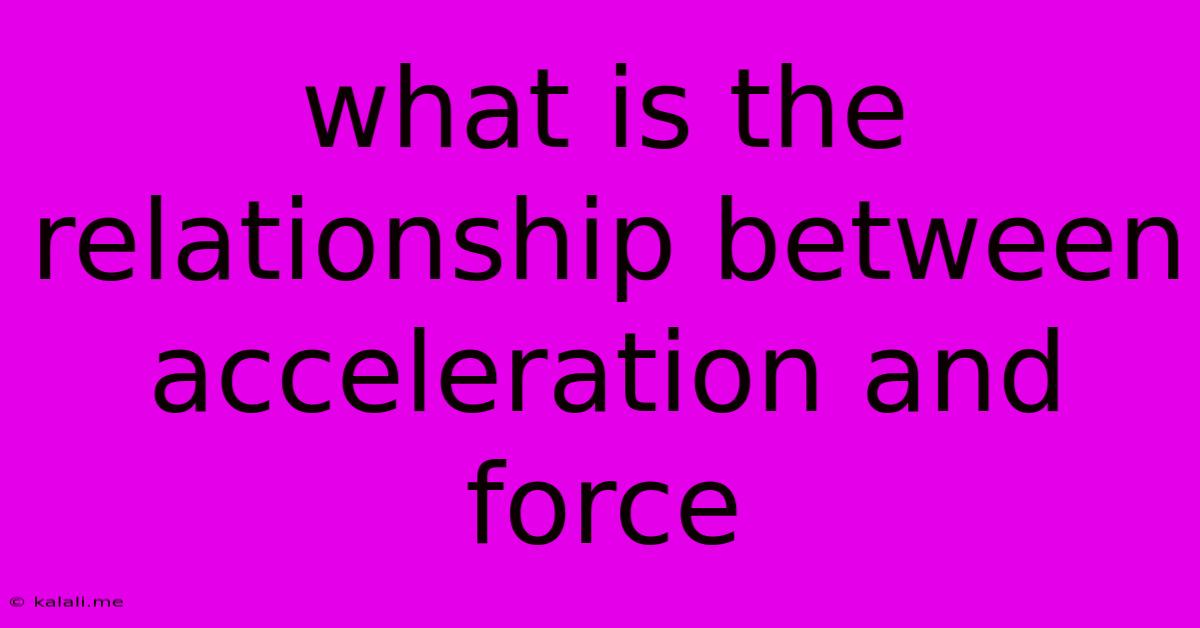What Is The Relationship Between Acceleration And Force
Kalali
Jun 12, 2025 · 3 min read

Table of Contents
The Inseparable Duo: Understanding the Relationship Between Acceleration and Force
Newton's second law of motion elegantly describes the fundamental relationship between acceleration and force: they are directly proportional. This means that a greater force results in a greater acceleration, and vice versa. This relationship is crucial in understanding how objects move and interact within the physical world, from the simple act of pushing a shopping cart to the complex mechanics of a rocket launch. This article will delve into the specifics of this relationship, exploring its implications and practical applications.
Newton's Second Law: The Foundation of the Relationship
The core of the acceleration-force relationship lies within Newton's second law of motion, often expressed as:
F = ma
Where:
- F represents the net force acting on an object (measured in Newtons). It's crucial to remember that this is the net force – the sum of all forces acting on the object. If forces are acting in opposite directions, they must be subtracted.
- m represents the mass of the object (measured in kilograms). Mass is a measure of an object's inertia, its resistance to changes in motion.
- a represents the acceleration of the object (measured in meters per second squared). Acceleration is the rate of change of velocity – how quickly the object's speed and/or direction is changing.
This equation reveals that acceleration is directly proportional to the net force and inversely proportional to the mass. Let's break this down:
- Direct proportionality to force: If you double the net force acting on an object, you double its acceleration (assuming mass remains constant). Conversely, halving the force halves the acceleration.
- Inverse proportionality to mass: If you double the mass of an object while keeping the net force constant, you halve its acceleration. A more massive object requires a greater force to achieve the same acceleration as a less massive object.
Practical Examples: Seeing the Relationship in Action
The relationship between acceleration and force is evident in numerous everyday scenarios:
- Pushing a shopping cart: Applying more force to the cart (pushing harder) results in a greater acceleration, causing it to speed up more quickly. A heavier cart (greater mass) will require more force to achieve the same acceleration as a lighter one.
- Driving a car: Pressing harder on the gas pedal increases the force applied to the car's wheels, leading to greater acceleration.
- Throwing a ball: The force exerted on the ball during the throw determines its acceleration and ultimately, its final velocity. A stronger throw (greater force) results in a higher velocity.
- Space travel: Rockets achieve immense acceleration by generating enormous thrust (force) from their engines. The mass of the rocket, including its fuel, significantly impacts its acceleration capabilities.
Beyond the Basics: Considering Other Factors
While F=ma is a fundamental equation, it's important to acknowledge that other factors can influence the relationship between acceleration and force in more complex scenarios:
- Friction: Friction opposes motion and reduces the net force acting on an object, thereby decreasing its acceleration.
- Air resistance: Similar to friction, air resistance affects the motion of objects, particularly at higher speeds, reducing acceleration.
- Gravity: Gravity is a constant force acting on objects near the Earth's surface, affecting their acceleration.
Understanding the relationship between acceleration and force is vital in numerous fields, including engineering, physics, and even sports science. By grasping this fundamental principle, we can better understand and predict the motion of objects in a wide variety of situations. From designing efficient vehicles to analyzing the performance of athletes, the application of Newton's second law is far-reaching and continuously relevant.
Latest Posts
Latest Posts
-
How Was The Byzantine Empire Different From The Roman Empire
Jun 13, 2025
-
What Is One Watt Equal To
Jun 13, 2025
-
Moment Of Inertia Of A Square Plate
Jun 13, 2025
-
Which Of The Following Is Not Secreted By The Pancreas
Jun 13, 2025
-
Which Of The Following Elements Has The Greatest Electronegativity
Jun 13, 2025
Related Post
Thank you for visiting our website which covers about What Is The Relationship Between Acceleration And Force . We hope the information provided has been useful to you. Feel free to contact us if you have any questions or need further assistance. See you next time and don't miss to bookmark.